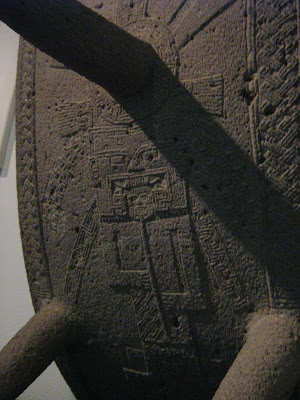At the Entrance


This spherical structure of steel and glass, introduces the new entrance to the National Museum. It is a reinterpretation based on stone sphere, one of the most symbolic objects of Costa Rica's pre-hispanic past. It features an original stone sphere.
Live butterfly exhibit


Pre-columbian exhibit

Metates
Grinding stones (Metates) for everyday, festive and religious ceremonial use Grinding stones or platforms (hereafter metates) and the mullets or handstands used on them were made of porous volcanic rocks. Employed with water, the grinding process produced a doughy mass usually of maize, but also of certain other seeds and tubers, like cassava. Grinding stone against stone produced recognizable patters of friction wear. Both metates and mullets (manos) became common in the archaeological record after around 500B.C., and there sculpted forms are recognizable as coming from different regions of Costa Rica. There were also special purpose ceremonial metates and in fact became the favored form for high-status stone sculpture during this period. The metates highlighted the importance of the control over agriculture and its products as a major power base for the leaders. Such metates were destined for only occasional ceremonial use, and if fact some of them may have been utilized as altars for display or even seats for powerful leaders during these ceremonies. In this period, the ceremonial metates of NW Costa Rica highlighted low-relief carving on the underside of the working grinding plate. Some of these very complex carvings show ritually costumed high-ranking shamans or chiefs with fancy headdress, feathered capes, staffs, weapons and other intricate clothing of leather and cloth.
Pre-columbian musical instruments
Music was a highly symbolic means of expression for our pre Columbian people. In Costa Rica we have an abundance of archeological evidence which shows plentiful musical and instrumental panorama. Wind instruments, such as flutes, ocarinas and whistles, were elaborated. We can also find shaking instruments such as jingles, maracas and rattles, and percussion instruments such as drums. The instruments were made out of clay, wood, bone (stone?) fruit, and metal (copper). Music became total with signing and dancing and was used in several ceremonies, especially shamanic ones.
Human Figure
This sculpture form is very similar in aesthetics to a work of modern art. A stylized human figure shown, wears a hairstyle or headdress, from the subregion of Diquís. The human form was an important part of symbolic representations of pre-columbian people. Located in public sites and important places, these representations were used to convey ideas related to politics and religion.
Special photo exhibit
Jean Claude Fignole, Lilavois, Haiti photographer Luis Alcala del Olmo

On the grounds




No comments:
Post a Comment